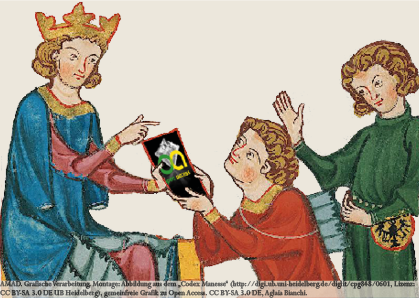AMAD
"Archivum Medii Aevi Digitale - Specialized open access repository for research in the middle ages"To submission

Full metadata record
| DC Field | Value | Language |
|---|---|---|
| Contributor | Inria Rennes – Bretagne Atlantique | - |
| Contributor | Ministère de la Culture et de la Communication ( MCC ) -Université de Tours-Centre National de la Recherche Scientifique ( CNRS ) | - |
| Contributor | Centre d'études supérieures de la Renaissance UMR 7323 ( CESR ) | - |
| Contributor | Institut National de Recherche en Informatique et en Automatique ( Inria ) | - |
| Author | Jimenes , Rémi | - |
| Author | André , Jacques | - |
| Date | 2013 | - |
| Other Identifier | https://halshs.archives-ouvertes.fr/halshs-00983575 | - |
| Other Identifier | https://halshs.archives-ouvertes.fr/halshs-00983575/file/10_Andr%C3%A9_Jimenes.pdf | - |
| Other Identifier | https://halshs.archives-ouvertes.fr/halshs-00983575/document | - |
| URI | https://www.amad.org/jspui/handle/123456789/109455 | - |
| Description | International audience ; Preserving as many informations as possible from the original document, a transcription of ancient printed text should serve as a basis not only for literary analysis, but also for palaeotypographic studies. With this aim, we require a standardized encoding able to preserve a unequivocal link between the characters of the digital transcription and those of the original source. We define here the new concept of typem, a transitional element between the notion of character and glyph as defined by Unicode. It is proposed here to use MUFI, an extension to the Unicode standard, by adding new code points dedicated to "typems", in order to produce what we call "typemic transcriptions", reproducing all the characters of the original document. Finally, a project of a census of all the typems, named PICA (Projet d'Inventaire des Caractères Anciens), is described. ; Conservant le plus grand nombre possible d'informations du document-source, une transcription de texte imprimé ancien devrait pouvoir servir de base non seulement à des analyses littéraires, mais également à des études " paléotypographiques ". Pour ce faire, il faudrait disposer d'un codage normalisé permettant d'assurer une correspondance univoque entre les caractères de la transcription numérique et ceux de la source originale. Le terme " caractère " pouvant prêter à confusion, nous introduisons un nouveau concept : celui de " typème ", intermédiaire entre le caractère et le glyphe tel qu'Unicode les définit. Nous proposons d'utiliser le codage MUFI, une extension d'Unicode, augmentée des typèmes attestés dans les imprimés anciens, afin de produire une transcription dite " typémique ", reproduction fidèle de la composition typographique du document original. Nous concluons sur la nécessité de réaliser l'inventaire des typèmes attestés dans les imprimés anciens, qui fera l'objet d'un Projet d'Inventaire des Caractères Anciens (PICA) actuellement à l'étude. | - |
| Language | fre | - |
| Rights | info:eu-repo/semantics/OpenAccess | - |
| Keywords | typographie | - |
| Keywords | Renaissance | - |
| Keywords | PICA | - |
| Keywords | caractères | - |
| Keywords | typèmes | - |
| Keywords | imprimés | - |
| Keywords | [ SHS.HIST ] Humanities and Social Sciences/History | - |
| Keywords | [ SHS.INFO ] Humanities and Social Sciences/Library and information sciences | - |
| Keywords | [ SHS.LANGUE ] Humanities and Social Sciences/Linguistics | - |
| Keywords | [ SHS.LITT ] Humanities and Social Sciences/Literature | - |
| Keywords | printed material | - |
| Keywords | typography | - |
| Keywords | encoding | - |
| Keywords | ancient document | - |
| Keywords | inventory | - |
| Keywords | types | - |
| Keywords | typems | - |
| Keywords | documents anciens | - |
| Keywords | codage | - |
| Keywords | Unicode | - |
| Keywords | MUFI | - |
| Keywords | inventaire | - |
| Dewey Decimal Classification | 940 | - |
| Title | Transcription et codage des imprimés de la Renaissance. ; Transcription et codage des imprimés de la Renaissance. : Réflexions pour un inventaire des caractères anciens | - |
| Type | info:eu-repo/semantics/article | - |
| Type | Journal articles | - |
| AMAD ID | 692857 | - |
| Year | 2013 | - |
| Open Access | 1 | - |
| Appears in Collections: | BASE (Bielefeld Academic Search Engine) General history of Europe | |
Files in This Item:
There are no files associated with this item.
Items in DSpace are protected by copyright, with all rights reserved, unless otherwise indicated.

